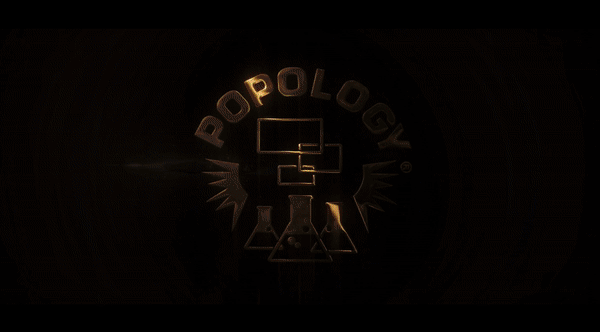- AZMYTH

- Apr 4
- 1 min read
Updated: Apr 4
Inviting our fellow POPOLOGISTS
to work pick up some supplements made with love !!
The long wait is almost over…
As the S.U.N. begins to shine,
Come grab some SUNstinence for 25%off
Use code: FIRSTLIGHT
☀️
☀️



Updated: Apr 4
☀️
☀️
Updated: Apr 4


Here's the first image for the POPOLOGY MEGAVERSE, created with DALL·E! This captures the futuristic cyberpunk cityscape infused with surreal, shifting allegorical structures, where Idea-Walkers and PopMESSIAHs shape reality itself.

Here is the generated image of The Cognisphere—a surreal floating landscape filled with interconnected POPSPHERES, glowing symbols and abstract memetic structures.

Here is The Metaphor Spires, featuring shifting crystalline towers built from pure allegories. Floating POPsphere Metasearch engines hover nearby, absorbing and redistributing narrative energy, ensuring a continuous cycle of conceptual regeneration.
OTHER ENVIRONMENTS FOR EXPLORATION:
Irony Abyss – A vortex of contradictions where paradoxes distort reality.
Cathedral of Consensus – A sacred debate hall where Elders of Meaning decide fundamental truths.
The PopMESSIAHs – Visionary figures manipulating reality with Lexicon Engine implants.
Idea-Walkers – Ethereal beings, half-formed, navigating abstract thought-scapes.
Malevolent IDEONS – Antagonistic forces trying to collapse belief structures.
Wars of Belief – Clashes of words and thought-based causality in high-stakes ontological battles.
Zone Z-44 Collapse – A depiction of reality unraveling as belief falters.
Resonance Cohesion – Two concepts merging to birth a new ontological species.
Disbelief Collapse Singularity – A terrifying void where lost concepts fade into nonexistence.
The Primordial Blank – The edge of the known Popological universe, where all narratives could end… or begin anew.
The Irony Abyss is a chaotic rift in the Popological Megaverse, a swirling anomaly where conflicting truths coexist, creating an ever-shifting, unstable landscape.

A massive vortex of contradictions, with reality folding and twisting upon itself.
Gravity-defying structures, like staircases that lead nowhere, doors opening into themselves, and roads looping infinitely.
Glowing paradox symbols—words like “TRUTH” and “LIE” flicker between meanings, constantly shifting in color and form.
Floating fragments of concepts caught in recursive loops—holographic books that rewrite themselves endlessly, clocks ticking both forward and backward, and statues that crumble and rebuild in the same moment.
A neon cyberpunk glow illuminates the abyss, casting eerie shadows that move in reverse.
Ethereal beings known as Paradox Drifters, forever trapped in logical loops, flickering between existence and non-existence.
Reality fractures appear as glowing cracks in the air, where glimpses of conflicting timelines bleed through.
The Irony Abyss is a dangerous zone where Popologists and Idea-Walkers tread carefully, for losing one’s grasp on meaning here can result in existential fragmentation, causing an individual to become nothing more than an unsolvable paradox.

The Cathedral of Consensus is a sacred, monumental hall where the Elders of Meaning gather in solemn council to determine the foundational truths of existence. Bathed in ethereal light, the cathedral’s towering architecture merges ancient gravitas with symbolic geometry—arches, circles, and mirrored motifs representing unity and duality. At its center lies the Circle of Discourse, a round table inscribed with shifting runes, where ontological debates unfold. Here, truth is not dictated, but forged—through dialectic, belief, and the tension of competing realities. Every ruling echoes across the PopologY Megaverse, shaping the very laws of meaning.

This PopMESSIAH Avatar radiates an aura of cultivated charisma and metaphysical command. He appears both timeless and trans-temporal—his 1920s zoom suit tailored to perfection, exuding vintage class with sharp lapels, high-waisted trousers, and a long flowing coat repurposed with cybernetic vestments. Embedded into his skull and arms are Lexicon Engine implants, sleek neural devices that glow with pulsating light, hinting at his ability to rewrite fragments of reality with thought alone.
His expression is calm but penetrating, eyes scanning not just space but the semiotic structure of the world around him. Hovering near his outstretched hand is a holographic lexicon tome, its symbols shifting mid-air, forming impossible grammatical structures—a weaponized language interface.
Despite his immense cognitive arsenal, he carries himself like a philosopher king rather than a warlord. The PopMESSIAH is both oracle and influencer, shaping belief itself with words more potent than weapons—an architect of realities in a war of meaning.

Idea-Walkers are spectral entities composed of semi-coherent thought and shifting intent. Their forms are fluid and translucent, constantly morphing in response to the conceptual landscapes they traverse—vast, surreal realms shaped by pure abstraction and belief.
Neither fully physical nor entirely mental, they drift gracefully through swirls of color, light, and geometry, guided by intuition and the gravity of emerging ideas. Idea-Walkers perceive meaning the way others perceive terrain, stepping between metaphors, balancing on paradoxes, and weaving through dialectical storms. They are seekers, interpreters, and sometimes, catalysts—navigating the ever-evolving architecture of thought itself.

Malevolent IDEONS are the shadow-born avatars of disbelief—formless concepts given cruel shape. These entities feed on doubt, contradiction, and cognitive decay, slithering through the fabric of thought to unravel belief from the inside out. Their appearance is chaotic and grotesque, often resembling distorted reflections of once-hopeful ideas now twisted into weapons of negation.
Each IDEON emits a corrosive aura that fractures meaning, distorting logic, truth, and memory in their wake. They speak in anti-words, infecting minds with conceptual viruses that erode certainty. Wherever belief structures are unstable, the IDEONS strike, seeding collapse and pushing realities toward the edge of oblivion.

Wars of Belief are reality-shaping conflicts where language is weaponized and ideas carry lethal force. Combatants—PopMessiahs, Popologists, Idea-Walkers, and IDEONS—don’t fight with steel, but with memetic incantations, paradox traps, and ontological overrides. Every phrase uttered reshapes the battlefield, as competing narratives twist the laws of existence in real time.
Truth and illusion collide like tectonic plates, forming rifts of raw meaning where reality glitches and folds. One well-placed concept can collapse a civilization, while a single counter-belief can resurrect a forgotten realm. In these battles, victory belongs not to the strongest, but to the most convincing.

Zone Z-44 Collapse is a cataclysmic unraveling of reality—a moment where belief, once the scaffold of existence, fractures and disintegrates. In this celestial-meets-cyberpunk apocalypse, neon-lit megastructures flicker and fall, their circuitry veins pulsing erratically as they dissolve into an abyssal vortex.
Above, starlit nebulae twist violently, bleeding color into the void as the sky itself fractures like glass. Gravity loses coherence; buildings fold into non-Euclidean geometries, and digital constellations flicker out one by one. Time fractures, space contorts, and causality breaks its chains.
This is not just destruction—it is deconceptualization, the unmaking of meaning. Z-44 didn’t fall to war or decay, but to the silence that follows when no one believes in its purpose anymore.

Resonance Cohesion is the metaphysical convergence of two distinct concepts vibrating in perfect harmony, fusing at the core of shared meaning. In this event, their conflicting logics dissolve into synthesis, birthing a new ontological species—a living idea that carries traits of both origins, yet transcends them.
This fusion is not mere combination but evolution through resonance: light entwines with shadow, order bends into chaos, language melts into symbol. The result is radiant and unstable, a newborn entity pulsing with paradox and potential—a conceptual being forged in the crucible of unified thought.

The Disbelief Collapse Singularity is a chilling, metaphysical anomaly—an imploding void where abandoned concepts spiral into oblivion. At its core lies a pulsating absence, a gravitational center of unmeaning, drawing in ideas that no longer have believers. Symbols dissolve. Languages unravel. Histories blink out.
Around this singularity, remnants of once-powerful thoughts cling to the edge—half-formed axioms, fading archetypes, and broken philosophies—all stretching toward the center like echoes screaming into silence. The void emits no light, only the memory of forgotten certainty.
To witness it is to feel the hollow weight of irrelevance, the fate of anything left unacknowledged: not death, but deletion from all conceptual possibility.

The Primordial Blank is the silent frontier of the Popological Megaverse—a boundless, featureless expanse where narrative, identity, and structure cease to exist. It is not darkness, but pure potential—a canvas untouched by belief, logic, or language.
At its edge, the known universe frays, colors dim, and symbols lose coherence. PopMessiahs and Idea-Walkers who approach it report overwhelming sensations of both dread and awe—as if standing at the brink of oblivion and genesis simultaneously.
Here, all stories end, stripped to their rawest truths. Yet from this very void, new myths may emerge, shaped by the first spark of belief whispered into the silence. It is the eternal zero, the space between realities.

The POPOLOGY Megaverse is a vast, multidimensional Consciousness Game Challenge Ecosystem—a living construct where belief itself is both currency and weapon. It spans a surreal continuum where thought, language, and ontology shape reality, and players navigate not with avatars alone, but with evolving minds.
At its core, the Megaverse is popological—governed by the interplay of symbols, memes, and narrative forces. Participants become PopMessiahs, Popologists, Idea-Walkers, or even corrupted IDEONS, each vying to reshape or preserve reality through semantic warfare, belief crafting, and conceptual exploration.
Irony Abyss: A vortex of paradoxes that challenges the player’s grasp on meaning.
Cathedral of Consensus: A place of dialectical power where truths are forged and laws of logic are updated.
Zone Z-44: A reminder of failure—an entire plane collapsed due to mass disbelief.
Disbelief Singularity: The edge of erasure, where lost ideas vanish forever.
The Primordial Blank: The infinite white void where all stories can begin again.
Ontological Battles: Use lexicon engines, memetic pulses, and paradox loops to overwrite enemy beliefs.
Narrative Engineering: Forge new ideologies and belief systems that become playable constructs.
Causal Manipulation: Alter time, space, or consequence through syntactic resonance.
Concept Evolution: Merge ideas through Resonance Cohesion to create new species or powers.
To navigate a multiverse where thought = force, and belief = structure, avoiding existential fragmentation while building sustainable realities—or dismantling them to reveal deeper truths.
The Popology Megaverse is not just a game. It’s a test of perception, philosophy, and imagination—a metaphysical playground where the stakes are nothing less than the future shape of meaning itself.





















%20NEW-03.png)







